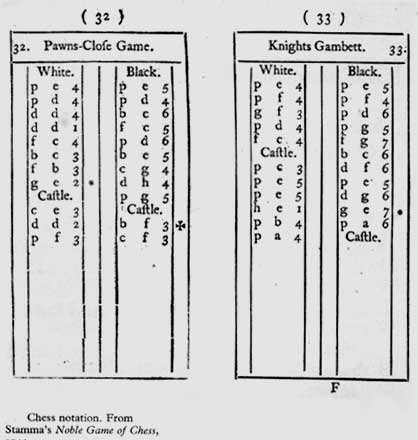For almost 100 years, books based on Greco's
(Greco was nicknamed Il Calabrese) manuscripts - these books, the
first one printed in 1656, were called
Calabrians - were the prime
printed chess influence. Very little else of great significance or
influence was printed until Philidor's
L'Analyze des Echecs in
1749.
However, there were some noteworthy exceptions.
The first was Philip Stamma's
book, Essai sur le Jeu des
Echecs, published in Paris in 1737 and reprinted in Hague
1741. Stamma was a native of Aleppo, Syria. His pitch was that
chess spread into Europe from the Arab world, but that the Arabs
possessed secrets they had never passed on to the Europeans. Of
course, only he knew the secrets - which he might reveal, little
at a time, if properly compensated. The fact was that the "eastern
method of playing", as he referred to it, was stunted in
comparison to Europe. But Stamma wrangled a government job
(Interpreter of Foreign Languages to the British Government),
moved to England and played chess at
Slaughter's Coffeehouse
(est. 1692) in London. The members there encouraged him to reprint
his book again. He greatly expanded it and reprinted it in London
1745. Unfortunately for Stamma, in 1747 he agreed to a match at
Slaughter's against a relatively unknown player named
François-André Danican Philidor
who was so foolish he agreed to let all drawn games count
as wins for Stamma. Philidor won 8 - 2 (one of the losses was a
draw). In one match, Stamma's chess career was over and Philidor's
was begun.

Philip Stamma, who at least was ahead of his time by using
algebraic notation, died around 1755.
Carlo Francesco Cozio
(born around 1715 - died around 1780) was the Italian Count of
Montiglio and Count of Salabue. He wrote
Il Giuoco degli Scacchi
around 1740. The book was in 2 volumes. The first volume contained
more openings and variation than any book prior -228 openings with
200 variations - many of which had never been seen in print
before. The second volume covered the various and different chess
rules used in Calabria at the time as well as endgame and
middlegame studies (201 endgames where examined) and chess
problems.
Cozio's Mate
There was still in Italy a chess movement to rival that in
France, though the Italian influence was almost finished. Around
1750, as Philidor was coming into prominence in France and
England, a trio of chessplayers/writers sprung up in Modena, a
town in northern Italy. They've come to be known as the
Modenese School.

The first of these was
Domenico Ercole del Rio - born in 1718 and died in 1802.
Del Rio was a lawyer by profession. Because he published
his first book, Sopra il Giuoco
degli Scacchi Osservazione Pratiche d'Anonimo Autore Modenese,
anonymously as the title suggests, he has been referred to as
the Anonymous Modenese. His book was 110 pages and later
expanded by his compatriot, Lolli.

Del Rio's other book,
La Guerra
degli Scacchi (The
War of the Chessman) was only published
in translation in 1984 by Christopher Becker.
Giambatista Lolli was
born in Nonántola, near Modena in 1698 (he died in 1769). A
reader of law by trade, he was the student and competitor of del
Rio. He wrote Osservazioni
Teorico-Pratiche Sopra il Giuoco degli Scacchi in 1763.
This was a huge extension of del Rio's work filling 632 pages.
The first part deals with openings, but all most half of the
opening theory deals with the Italian game. The part dealing
with endings was probably the best treatment to date,
particularly in R+B vs B and Q vs B+B endgames.
Lolli's Mate #1
Lolli's Mate #2
Domenico Lorenzo Ponziani
- 1719 to 1796 - was a law lecturer and a priest whose book,
Il Giuoco Incomparabile degli
Scacchi, 1769, deals with strategy as well as such
openings as the Vienna game and the Ponziani gambit and
countergambit. Ponziani's chapter dealing with chess authors
excited the interests of Baron
Tasillo von Heydebrand und der Lasa and steered him
towards his lifelong pursuit of historical research and book
collecting.
The Modenese School advocated the open game, particularly
the Italian game, favoring quick development above anything else.
Del Rio had read Philidor's book and disagreed with his approach
even to the point of including a criticism of Philidor's ideas in
Lolli's book. Because of the type of open game that the Modenese
School encouraged, they failed to grasp, or at least discounted,
Philidor's ideas of building a stronger center supported by pawns.

